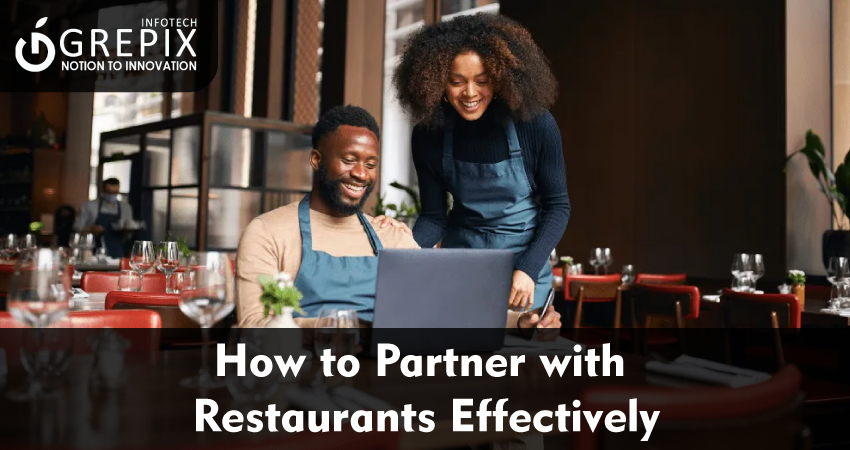How to Partner with Restaurants Effectively
The rise of digital dining has transformed how consumers connect with their favorite foods and food delivery apps are at the heart of this shift. For any restaurant partnership food app, successful onboarding of restaurant partners is crucial to growth, customer satisfaction, and market dominance. Navigating this modern marketplace means understanding the unique benefits of restaurant collaboration, mastering win win strategies, and leveraging the latest onboarding techniques to partner with food delivery apps in a way that builds enduring value for everyone involved.
The food delivery market has never been more dynamic, with restaurants striving for greater reach and delivery apps seeking deeper partnerships. This guide explains how a restaurant partnership food app can onboard restaurants delivery app style, ensuring smooth restaurant collaboration and successful partnerships for food delivery apps. You’ll discover expert onboarding steps, benefits for restaurants, proven strategies, and real-life examples including insights from leading brands and current industry statistics. Whether you’re scaling a new food app or refining your approach to partner with food delivery apps, this SEO-optimized guide will drive your results and position your brand as a top choice in the digital dining revolution.
Why Restaurant Partnerships Matter
The Explosion of On-Demand Dining
In 2025, global revenue from the online food delivery market is projected to exceed $1.4 trillion proof that digital delivery isn’t a trend, it’s a transformation. Restaurant partnership food app solutions have given small family eateries and global chains unprecedented reach.
Revenue and Reach Benefits
- Restaurants joining a delivery platform see a 42% average revenue jump in the first year.
- The average order value (AOV) through apps is 32% higher than dine-in orders, thanks to bundles and upselling.
Platform Power
With millions of users and strong demand in India alone, food and dining apps saw nearly two billion downloads in 2024 both restaurants and food delivery apps can’t afford to ignore the value of strategic partnerships. Onboarding restaurants delivery app-style is a game-changer for scaling efficiently and delighting customers everywhere.
The Onboarding Process: Step by Step
Smooth onboarding is where the journey of restaurant collaboration truly begins. Here’s a blueprint to onboard restaurants delivery app partners for success:
Research and Target the Right Partners
- GIdentify local favorites, trending cuisines, and influential chefs.
- GUse data to spot popular independent restaurants in your target region.
Transparent, Restaurant-Friendly Terms
- GOffer clear commission structures. Studies show that 45% of independent restaurants worry about hidden fees transparency builds trust.
- GProvide flexible pricing models, like reduced commissions for high-volume partners or trial periods with 0% fees.
- GShare examples, such as a European food app offering 10% commissions versus the 20–30% industry norm, resulting in higher sign-up rates.
Seamless Technology Integration
- GEnsure POS compatibility and menu syncing for all partners.
- GStreamline account set-up with guided support or dedicated onboarding specialists 58% of restaurant owners say ease of integration is their top priority.
- GAutomate menu updates, availability, and pricing.
Fast, Feature-Rich Onboarding Experience
- GEnable self-service signups with tutorials, FAQ support, and real-time chat.
- GAssign account managers for premium partners to assist with launch marketing.
Solid Logistics Support
- GOffer reliable delivery networks, real-time order tracking, and temperature-controlled solutions.
- GLet partners choose between platform-provided or self-managed delivery to suit their operations.
Marketing and Data Tools
- GProvide detailed analytics dashboards so restaurants see trends, peak hours, and customer demographics.
- GPromote launch offers, run sponsored listings, and enable A/B testing of menu deals.
Community and Social Proof
- GHighlight testimonials, revenue-growth case studies, and video reviews from current partners. This can boost sign-up rates by up to 88%.
Real-Life Case Studies
Rapid Growth with a Custom-Built Onboard Restaurants Delivery App
A local startup in India launched a restaurant partnership food app with a frictionless onboarding process real-time menu syncing, simple registration, and region-specific support. Within three months, the app added 500 restaurants, and saw order volumes increase by 200%. Success was driven by its focus on local cuisine and community events.
Streamlining National Chains
A leading North American pizza chain onboarded restaurants delivery app-wide by integrating all store locations into one management dashboard. Standardized training and a launch day promotion led to a 30% boost in app-driven sales within six weeks.
Data-Driven Restaurant Collaboration
A US salad bar chain focused on advanced analytics, using order trends and peak-hour reports from their food delivery app partner to optimize menu design and staffing. Result: a 15% higher order value after menu adjustments and targeted deals.
Benefits of Partnering for Restaurants
Why do thousands of restaurants clamor to partner with food delivery apps? Here’s what’s in it for them:
Expanded Customer Reach
Millions of app users search for new tastes daily. Restaurant collaboration means tapping audiences far beyond walk-in regulars a lifeline for local diners during and after the pandemic era.
Increased Revenue and Order Value
- 42% revenue increase in the first year for restaurants using third-party delivery platforms.
- 32% higher ticket size for delivery versus dine-in, due to bundles, cross-selling, and digital upsells.
- Quick service restaurants (QSRs) report that up to 75% of their sales are generated online.
Streamlined Operations
Food delivery apps handle payment, order management, and customer queries, allowing partners to focus on food quality and kitchen efficiency.
Greater Marketing Reach and Insights
- Featured placements, “super customer” promos, and loyalty rewards boost visibility.
- Analytics tools provide actionable insight into best-selling menu items and customer ordering trends.
Risk Sharing and Logistics Support
- Delivery app partners can offer fleet management or let restaurants use their own drivers.
- Comprehensive insurance, real-time support, and AI-powered logistics mean fewer headaches for restaurateurs.
Enhanced Brand Recognition
- Strong online ratings and app features drive more reviews and referral traffic.
- Being part of a respected delivery platform lends credibility and trust.
Win-Win Strategies for Restaurant Collaboration
Genuine, lasting restaurant collaboration is built on mutual benefit. Here are actionable strategies to ensure restaurant partnership food app relationships succeed:
Prioritize Transparent Communication
- Set expectations for performance, order timing, and commission rates upfront.
- Share weekly performance reports and host regular check-ins with restaurant partners.
Co-Marketing and Promotions
- Launch co-branded campaigns such as “Order 3 Times, Get a Free Dessert.”
- Feature local favorites in homepage banners and “must-try” lists for new customers.
Customization for Restaurant Needs
- Support local-allergy guides, vegan options, and limited-edition menu launches.
- Provide flexibility in menu offer timing let partners run peak-hour deals or discount off-peak items.
Emphasize Community
- Host “Support Small Saturday” events spotlighting independent or minority-owned restaurants.
- Partner with local charities for “Give Back” meal campaigns, deepening community ties.
Technology and Analytics
- Equip partners with dashboards showing average preparation time, top-rated drivers, and seasonal order surges.
- Suggest menu tweaks or run test offers using A/B analytics tools, driving up customer satisfaction.
Revenue-Boosting Features
- Offer options like cloud kitchens or virtual brands, helping partners expand with lower capital outlay.
- Enable cross-promotion with grocers, caterers, or beverage brands for added store traffic.
Conclusion
In today’s hyper competitive food delivery sector, the path to dominance lies in building rich, sustainable partnerships with restaurants. For any restaurant partnership food app, onboarding restaurants delivery app style is more than ticking boxes it’s about creating value for all. Restaurants gain new revenue, brand reach, and streamlined logistics, while food apps unlock user growth and market relevance. Restaurant collaboration is vital to keep both platforms and partners thriving. By prioritizing transparency, tech enablement, community engagement, and ongoing win-win strategies, every food delivery brand can become the platform restaurant owners recommend and the first choice for hungry customers everywhere.
Whether rolling out a new food platform or scaling your existing delivery operation, act now: research ideal partners, optimize onboarding, and create programs that help both sides grow. The future of on-demand dining rewards those who invest in true collaboration. Ready to build your next restaurant partnership food app success? Start reaching out, and make every meal a shared celebration.
FAQs
1. What are the best platforms to partner with for restaurant delivery?
Top choices include Uber Eats, DoorDash, Grubhub, and local apps with strong customer bases. Check each platform’s commission structure, market presence, and tech integrations for best results.
2. How do food delivery apps onboard new restaurants?
Most provide self-service signups with menu syncing, staff training, promotional support, and POS integration. Expect an onboarding period of 1–7 days depending on the complexity and partner readiness.
3. What are typical commission rates for restaurant partnership food apps?
Commission can range from 10% to 30% per order, with average industry rates around 20–30%. Many apps offer introductory rates or volume-based discounts.
4. How do restaurants benefit from food delivery partnerships?
Key benefits are increased order volume, broader customer reach, valuable marketing, and operational support. Recent statistics show a 42% average revenue boost for first-year partners.
5. What makes a successful restaurant collaboration?
Transparency, flexibility, shared marketing, tech support, and data-driven decision-making all form the foundation for a happy, profitable partnership for both sides.







